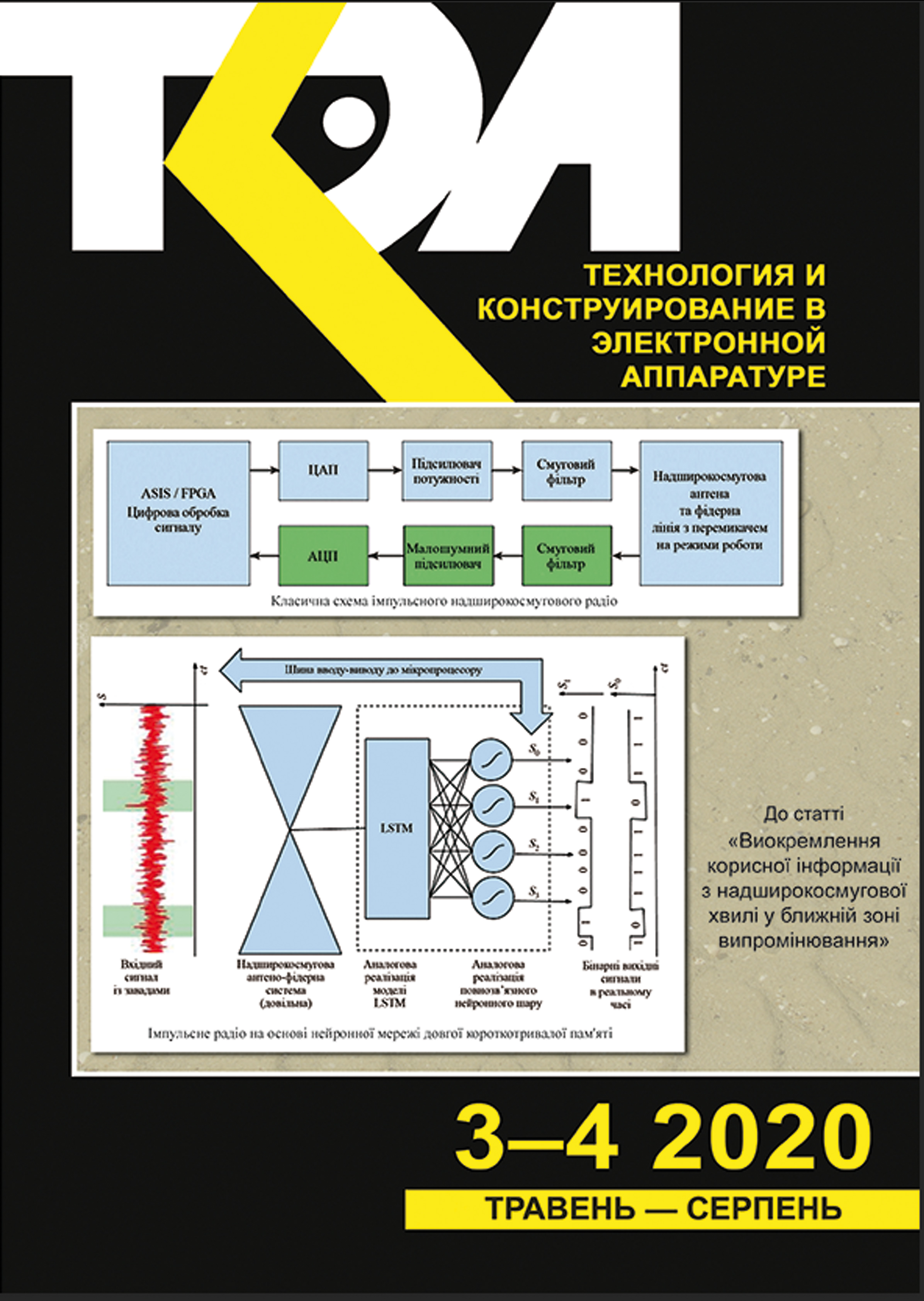Electronic characteristics of CdS quantum dots with defects
Abstract
Using the density functional theory and the generalized gradient approximation, we calculated the atomic structure, the density of electronic states, and the optical absorption spectra of CdS quantum dots containing intrinsic defects — a cadmium vacancy VCd and an interstitial sulfur atom SI, and substitutional impurities — zinc and copper in place of the atom cadmium — ZnCd and CuCd, respectively. The calculations were performed for the Cd33S33 cluster corresponding to the so-called "magic" size of the quantum dot. This size has a minimum of dangling bonds at the surface and allows the using of such a cluster without the passivation. The structural relaxation during the formation of such defects and the distribution of the wave function of the state corresponding to the top of the valence band are analyzed in details. It has been shown that the cadmium vacancy forms local states in the band gap of CdS nanocrystals, and can serve as centers of radiative recombination. Other defects form energy levels in the depths of the valence band or near its top, but whose energy positions do not correspond to the band maxima in the experimental photoluminescence spectra of CdS quantum dots, both undoped and doped with zinc. The calculated optical absorption spectra demonstrate a strong peak in the region of fundamental absorption of CdS for a cluster containing a substitutional impurity of CuCd, in contrast to other systems where no such peaks are observed. In addition, the replacement of the cadmium atom with copper leads to a decrease in the number of chemical bonds to three and, accordingly, to the largest relaxation among the systems studied. This feature is caused by the crystal structure inhomogeneity of copper sulfide CuxS, which, depending on stoichiometry, can be either a semiconductor or a metal.
References
Korbutyak D.V., Kovalenko O.V., Budzulyak S.I. et al. Light-emitting properties of A2B6 semiconductor quantum dots. Ukrainian Journal of Physics. Reviews, 2012, vol. 7, iss. 1, pp. 48–95. http://archive.ujp.bitp.kiev.ua/index.php?lang=uk&item=r&id=12 (Ukr)
Klimov V.I. Nanocrystal Quantum Dots., USA, Boca Raton, CRC Press, 2010, 485 p.
Rudko G.Y., Vorona I.P., Fediv V.I. et al. Luminescent and optically detected magnetic resonance studies of CdS/PVA nanocomposite. Nanoscale Research Letters, 2017, vol .12, iss. 1, pp. 130–137. https://doi.org/10.1186/s11671-017-1892-4
Skobeeva V.M., Smyntyna V.A., Sviridova O.I. et al. Optical properties of cadmium sulfide nanocrystals obtained by the sol-gel method in gelatin. Journal of Applied Spectroscopy, 2008, vol. 75, iss. 4, pp. 576–582. https://doi.org/10.1007/s10812-008-9074-x
Mandal P., Talwar S.S., Major S.S., Srinivasa R.S. Orange-red luminescence from Cu doped CdS nanophosphor prepared using mixed Langmuir–Blodgett multilayers. Journal of Chemical Physics, 2008, vol.128, iss. 11, pp. 114703–114710. https://doi.org/10.1063/1.2888930
Lee H., Yang H., Holloway P.H. Functionalized CdS nanospheres and nanorods. Physica B: Condensed Matter, 2009, vol. 404, iss. 22, p. 4364–4369. https://doi.org/10.1016/J.PHYSB.2009.09.020
Yuan S.Q., Ji P.F., Li Y., Song Y.L., Zhou F.Q. Unusual blueshifting of optical band gap of CdS nanocrystals through a chemical bath deposition method. Advances in OptoElectronics, 2015, vol. 2015, 5 p. https://doi.org/10.1155/2015/317108
Smyntyna V., Semenenko B., Skobyeyeva V., Malushyn M. Effect of surface on the luminescence properties of CdS nanocrystals. Electronics and information technologies, 2012, iss. 2, pp. 45–50. http://elit.lnu.edu.ua/pdf/2_4.pdf (Ukr)
Kupchak, I., Serpak, N., Kapush, O., Korbutyak, D. Electronic Properties of Surface Vacancies in CdS Nanocrystals. Physics and Chemistry of Solid State, 2018, vol. 19, iss. 1, pp. 34–39. https://doi.org/10.15330/pcss.19.1.34-39
Korbutyak D.V., Kladko V.P., Safryuk N.V. et al. Synthesis, luminescent and structural properties of the Cd1–xCuxS and Cd1–xZnxS nanocrystals, Journal of Nano- and Electronic Physics, 2017, vol. 9, iss. 5, p. 05024. https://doi.org/10.21272/jnep.9(5).05024
Muruganandam S., Anbalagan G., Murugadoss G. Synthesis and structural, optical and thermal properties of CdS:Zn2+ nanoparticles. Applied Nanoscience, 2014, vol. 4, iss. 8, pp. 1013–1019. https://doi.org/10.1007/s13204-013-0284-z
Unni C., Philip D., Smitha S.L. et al. Aqueous synthesis and characterization of CdS, CdS:Zn(2+) and CdS:Cu(2+) quantum dots. Spectrochimica Acta, Part A: Molecular and Biomolecular Spectroscopy, 2009, vol. 72, iss. 4, pp. 827–832. https://doi.org/10.1016/j.saa.2008.11.027
Orii T., Kaito S., Matsuishi K. et al. Photoluminescence of CdS nanoparticles suspended in vacuum and its temperature increase by laser irradiation. Journal of Physics: Condensed Matter, 2002, vol. 14, iss. 41, pp. 9743–9752. https://doi.org/10.1088/0953-8984/14/41/329
Giannozzi P., Baroni S., Bonini N. et al. QUANTUM ESPRESSO: a modular and open-source software project for quantum simulations of materials. Journal of Physics: Condensed Matter, 2009, vol. 21, iss. 39, pp. 395502–395541. http://stacks.iop.org/0953-8984/21/i=39/a=395502
Perdew J.P., Burke K., Ernzerhof M. Generalized Gradient Approximation made simple. Physical Review Letters, 1996, vol. 77, iss. 18, pp. 3865–3868. https://doi.org/10.1103/PhysRevLett.77.3865
Methfessel M., Paxton A.T. High-precision sampling for Brillouin-zone integration in metals. Physical Review B, 1989, vol. 40, iss. 6, pp. 3616–3621. https://doi.org/10.1103/PhysRevB.40.3616
Fletcher R. Newton-like methods. In book: Practical Methods of Optimization. USA, NJ, John Wiley & Sons, Ltd, 2010, 436 p. https://doi.org/10.1002/9781118723203.ch3
Kasuya A., Sivamohan R., Barnakov Y.A. et al. Ultra-stable nanoparticles of CdSe revealed from mass spectrometry. Nature Materials, 2004, vol. 3, pp. 99–102. https://doi.org/10.1038/nmat1056.
Puzder A., Williamson A.J., Gygi F., Galli G. Self-healing of CdSe nanocrystals: first-principles calculations. Physical Review Letters, 2004, vol. 92, iss. 21, 4 p. https://doi.org/10.1103/PhysRevLett.92.217401
Pathan H.M., Desai J.D., Lokhande C.D. Modified chemical deposition and physico-chemical properties of copper sulphide (Cu2S) thin films. Applied Surface Science, 2002, vol. 202, iss. 1-2, pp. 47–56. https://doi.org/10.1016/S0169-4332(02)00843-7
Hassan A., Zhang X., Liu X., et. al. ACS Nano, 2017, vol. 11, iss. 10, pp. 10070–10076. https://doi.org/10.1021/acsnano.7b04414
Zhang N., Liu X., Wei Z. et al. Cell imaging using two-photon excited CdS fluorescent quantum dots working within the biological window. Nanomaterials, 2019, vol. 9, iss. 3, p. 369. https://doi.org/10.3390/nano9030369
Xu X., Zhao Ya., Sie E.J. et.al. Dynamics of bound exciton complexes in CdS nanobelts. ACS Nano, 2011, vol. 5, iss. 5, pp. 3660–3669. https://doi.org/10.1021/nn2008832
Copyright (c) 2020 Kupchak I. M., Korbutyak D. V., Serpak N. F.

This work is licensed under a Creative Commons Attribution 4.0 International License.

